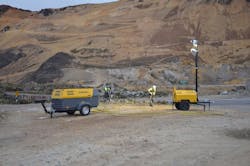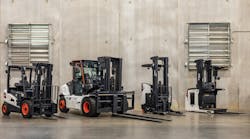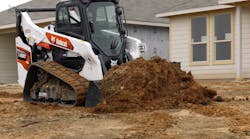Asset management has become more critical in recent years, as equipment managers focus attention on containing heavy-equipment costs in a stagnant economy. Light equipment is no exception. This wide variety of equipment—including generators, welders, vibratory plate compacters and more—cannot be overlooked.
“When the economy was very, very strong, a lower capital-intensive piece of equipment was very easy to replace. There was always extra room in the budget,” says Rus Warner, manager of global air products for Doosan Portable Power. “But now the economy is still not fully recovered, so cash flow is important and those purchasing decisions are more highly scrutinized.”
Construction companies and rental houses must balance the financial need to extend equipment life with the production need for high performance. Light-equipment management programs include tracking the location of the pieces for greater utilization and prevention against theft as well as tracking owning and operating costs in order to extend the life of these pieces and stay on top of maintenance requirements.
Location, location, location
Theft is a major threat to light equipment. Although technological advancements such as GPS or Radio Frequency Identification (RFID) have proven advantageous for tracking heavy equipment, they are less prevalent in light-equipment management.
“The cost of installing such equipment, or the space available to install such a system, doesn’t exist,” says Juan Quiros, product development director at Multiquip. “It can’t be justified because it costs too much to install a transponder for what the value of the equipment is.”
Larger pieces still in the light equipment category, however, may be outfitted with location devices.
“Some companies set purchase price or dollar value limits on the equipment, and that will determine if electronic monitoring will be installed or maintained,” says Jim Siffring, a product manager at Atlas Copco Construction USA. “It often depends on a company’s ‘level of pain’ that they are willing to tolerate as a loss.”
Companies have found other ways to keep track of the equipment’s location by using enterprise research planning (ERP) software systems for a more cost-friendly management solution.
Kokosing Construction Co. has had a separate light equipment management group for more than 25 years; it also acts as an in-house rental house. Tim Truex, midsize equipment manager at Kokosing, splits the fleet into two separate categories when keeping track of location.
“The larger pieces are treated like any larger piece of equipment,” Truex says. “I can pull up a job and look at any equipment on there in our ERP system.”
These larger pieces include anything on wheels that would need to be towed or trucked to a job, according to Truex. The system for handling smaller items that people can pick up and carry away, however, is quite different.
“We do what’s called a ‘toolbox program’ that’s built into our ERP system, and all those pieces are assigned to an individual, and his toolbox follows him wherever he goes in the system,” Truex says.
It is the responsibility of the individuals who were assigned the tools to let Truex and his team know if they lend the tools to another person or if they leave them at a job.
“It definitely drives some accountability for the guys,” Truex says. “We don’t have a real transient workforce, especially at that level, so these guys take pride in taking care of that stuff.”
These foremen or superintendents have the option of renting the equipment for free, other than any service costs required, once the piece of equipment is paid off.
In addition to accountability, some rental houses have found other ways to address the problem of theft when it comes to light equipment.
“We have learned over the years, certain items are targeted for theft: generators, pressure washers and trailers, to name a few,” says Mark Campbell, general manager at Mainland Tool in Texas City, Texas. “It helps to have deposits built in for these items. If someone has the intention of stealing the equipment, they usually are not willing to pay a deposit.”
Mainland Tool finds another way to stay on top of thefts or misplaced or forgotten items is to keep in touch with the customer and utilize the company’s computer system for overdue contracts, according to Campbell.
Track owning and operating costs
The reasons to track owning and operating costs are the same for light equipment as they are for most other pieces of equipment. These costs enable fleets to schedule preventive maintenance, make repair or replace decisions, compare costs between two different brands, set rental rates, or decide whether to buy or rent.
“Increasingly, manufacturers are using digital tachometers and hour meters on selected models like light compaction equipment,” Quiros says. “In the past it was just guesswork: ‘Is it time to change the oil?’ ‘How many hours were on the machine when it left the shop?’”
Now, these types of meters can better track hour intervals, air-cleaning servicing, and fuel-filter servicing.
Not only do these numbers allow companies to look at what the performance-versus-costs ratio was when negotiating for new equipment, but they also can be used to compare two products.
“For example, when comparing two trash pumps, one brand may have a slightly lower acquisition cost, but the cost of common wear parts such as impellers or mechanical seals may lead to greater operating costs over the life of the pump,” Quiros says.
These same costs can also show whether renting a piece of equipment or buying it is the more cost-effective solution.
“Tracking owning and operating costs also allows us to set our internal rental rate at a level to keep us competitive but still cover our costs,” Truex says. Paying close attention to these costs gives Kokosing a competitive advantage by allowing it to rent out its 12,000 pieces of equipment (6,000 of which burn fuel) in the light equipment category at a calculated rate, according to Truex.
Owning and operating costs can also raise red flags when trying to make a repair or replace decision.
“Tracking your cost of ownership via repair costs, you can understand when a piece of equipment is breaking down more frequently and causing more downtime and costing more than its worth,” Joe Gitter, product manager at Miller Electric, says. Then it may be more beneficial to buy new equipment.
Extending equipment life
In the past, many construction companies treated light equipment as consumables, simply using a piece of equipment until it died. Manufacturers today, however, are seeing more emphasis on maintenance.
“Years ago when I first started in the industry, they didn’t pay too much attention to maintenance cost on the smaller stuff,” Warner says. “Even if the acquisition price isn’t as high as a major piece of equipment, the cost of failure is still quite high.”
Companies, however, can take different approaches to maintenance. Kokosing has 15 mechanics who take care of light equipment repairs.
“We control our own destiny,” says Truex. “We control the quality of the repairs; we control the availability of the equipment; and we also ultimately control the cost of the projects to make the company more successful in their future bids.”
Almost all of Kokosing’s repairs occur in-house, but there are other options. Paul McClendon, regional sales manager for Chicago Pneumatic, has seen clients outsourcing light equipment repairs.
“There are more and more small-engine repair facilities,” he says. “They’ve recognized there’s an opportunity for small-tool repair.”
Also, sometimes companies with one maintenance team may find light equipment is placed to the side.
“As business picks up, a common problem is that fleet service requirements increase, and it is common for big-ticket items to get service priority over small equipment,” Quiros says.
Multiquip has constructed a nationwide network of authorized service centers that agree to service this light equipment in a timely fashion if a contractor brings it in, according to Quiros.
“This resource helps relieve the backlog for their own technicians while enabling their fleet to run at full strength,” he says.
Other construction companies rely on a combination of in-house and outsourced maintenance to keep their light equipment up and running.
“A lot times people will hire a planned maintenance interval (PMI) service or some type of service that will come on-site and perform the maintenance,” says Warner. “That is an outsourced way to do maintenance that’s pretty cost-effective for some contractors who don’t want to invest in the labor that that would take.”
Finding ways for equipment to run longer not only eliminates an ongoing need for further acquisition but also decreases disposal costs, according to Warner.
“The ‘use it until it dies’ mentality would scare me,” he says. “There’s a significant amount of metal, batteries, oil, fluids and all kind of stuff that would have to be properly disposed of, so that’s a cost, a big cost.”
By placing more of an emphasis on light equipment management programs, including tracking owning and operating costs, recording locations of pieces, and following maintenance schedules, construction companies and rental houses can benefit no matter the state of the economy.
“It all drives where your money is going,” says Gitter. “Those companies that take the time to manage their assets will lose less in the small items and get more for their investment.”





